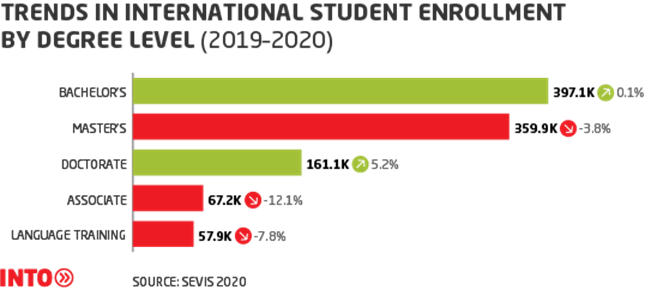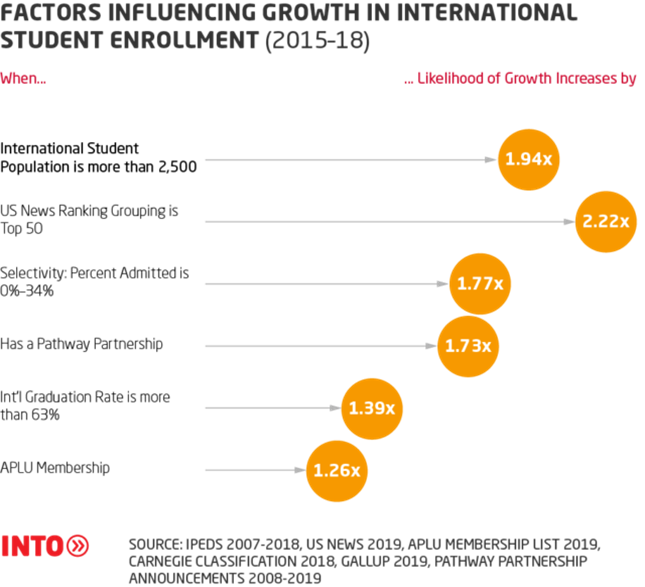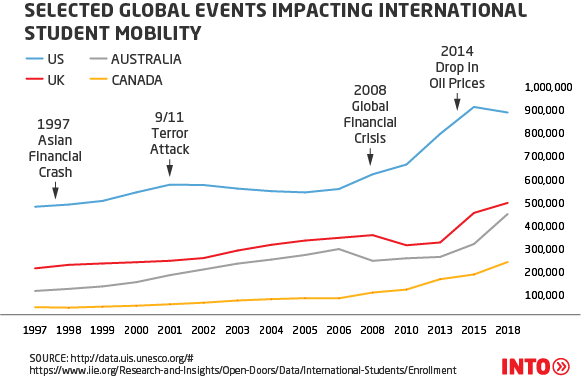The proof is in the partnership: NAFSA, APLU, and INTO analysis finds universities with recruitment/pathway partners are more likely to see international enrollment growth

The release of the Institute of International Education’s annual Open Doors data this week made for sobering reading among the American higher education community. Before we provide our take on the findings, we want to offer some key context to the declines we saw in 2019/20.
For more than one year, INTO University Partnerships has collaborated with NAFSA: Association of International Educators and the Association of Public and Land-grant Universities (APLU) to analyze two decades of international enrollment trends from across United States higher education institutions. Drawing data from 11 publicly available sources, our three groups published Factors Influencing International Student Enrollment Growth and Decline: A Multi-Factor Analysis of Two Decades of Data with Implications for the Future.
Among other factors, our analysis found that, in most cases, universities which partnered with a third-party recruitment or pathway organization were significantly more likely to experience increases in new international student enrollments (NSEs). Drawing on lessons from pre-pandemic declines in NSEs across the country, and from historic crises that previously impacted on international student mobility, the report also offers universities a roadmap for recovery from COVID-19 via strategic shifts to future international recruitment efforts.
Even before COVID-19, U.S. universities experienced declines in NSEs for several reasons, from increased competition from other English-speaking study destinations, to increased capacity for local delivery of tertiary education, to increased rates of visa denials. After sustained international enrollment growth driven by China and India between 2007 and 2015, NSEs have decreased by 10% since 2016.
Between 2015 and 2018, lower numbers of sponsored Saudi Arabian students drove a disproportionate decline of 39.7% in international enrollments in intensive English language programs and a 13.3% decline in enrollments in associate degree programs. This, in turn, precipitated in a 1.2% decline in undergraduate enrollments from 2017 to 2018. Meanwhile, lower numbers of Indian student enrollments led to a 2% decline in enrollment at the master’s level from 2017 to 2018.
From 2019-2020, international student enrollments in English language and associate degree programs fell by a further 7.8% and 12.1%, respectively, while master’s program enrollments fell by 3.8%.

Despite widespread declines, our analysis showed one factor in particular helped universities to buck the national trend and grow their international enrollments in the years leading up to COVID-19: partnership with a third-party recruitment or pathway organization. Universities that worked with a third-party recruitment partner like INTO were 1.73 times more likely to experience increased NSEs between 2015 and 2018—a time when most U.S. higher education institutions were losing international students. The only other factors that affected actual international enrollment growth more significantly were a university’s global profile—their national and global ranking and selectivity—and the size of a university’s international population.

In addition to factors influencing recent international student enrollment levels, the report covered four crises that impacted on global student mobility and offer important context for COVID-19: the Asian financial crisis of 1997, the terror attacks of September 11, 2001, the Great Recession of 2008, and a significant drop in oil prices in 2014. While the effects of these crises were relatively contained, they offer important lessons on resilience and recovery for universities grappling with the negative economic impacts, even existential crises, of COVID-19.
Although the 1997 Asian financial crisis led to a 58% decrease in the number of Malaysian student enrollments at U.S. universities over eight years, it also marked the start of Malaysia’s rise as a hub for higher learning, including overseas campuses for Australian and British universities. In the five years following 9/11, not only did Chinese and Indian student applications to U.S. universities fall by 76% and 58%, respectively, but Chinese and Indian student applications to U.K. universities increased by 36% and 16%, respectively. Chinese and Indian student applications to Australian universities also increased by 25% and 31%, respectively. And, rather than bringing international student mobility to a standstill, the Great Recession corresponded with an acceleration of mobility as it pushed students to reorient their study around employment and demanded that U.S. universities develop more intentional approaches to international recruitment.

What lessons can we derive from these historic shifts in mobility? For one, international students are resilient, and their drive to study abroad does not simply disappear—not even in the face of global crises. Rather, demand moves in different directions depending on global goings-on. Second, international students are increasingly motivated to study abroad by post-graduate employment prospects, something that has solidified during the pandemic. Finally, U.S. universities continue to face increased competition from around the world. Other English-speaking study destinations have embedded the welcoming of international students in their national policies, and it will take an intentioned approach at the national and institutional levels to maintain universities’ pipelines of international talent.
Looking to the future, as universities implement nimbler operations in the wake of COVID-19, the report asserts that U.S. higher education institutions “must realign, rethink, and rebuild despite diminishing resources.” If able, universities should double down on efforts to expand their global footprint, replicate intercultural exchange online, and connect students with internship and employment opportunities in their home countries. It is a daunting challenge, but, as our report confirms, it is more likely to be achieved through the development of partnerships that support the university mission and ambition.